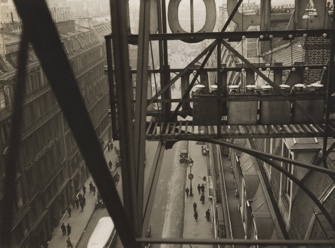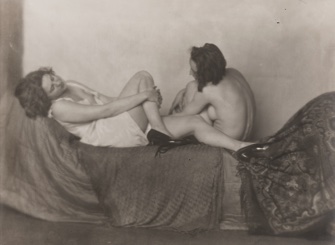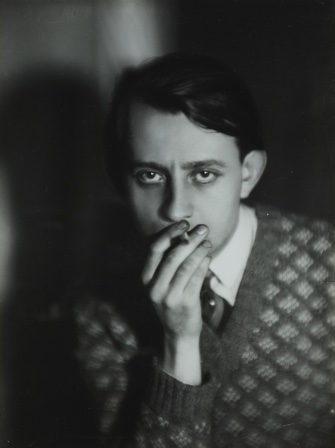One Woman’s Century:
Revolution, Erotica & Ads

“Rue Auber à Paris” (c. 1928). © Estate Germaine Krull, Museum Folkwang, Essen
Germaine Krull’s versatility as a photographer echoes the varied tapestry of her life experience. The current exhibition of her work at the Jeu de Paume, “Germaine Krull: Un Destin de Photographe,” features images ranging from brutal Soviet-style adulations of silos and factories to intimate model shots for the Parisian atelier of artist and textile designer Sonia Delaunay and sleek aspirational adverts for cold cream.
Krull, born in 1897 in Wilda, Posen (now Poznań, Poland), lived for almost 90 years, and the exhibition offers a bird’s-eye view of the previous century from the vantage point of a woman who wanted to both document reality and change it for the better.
After a stint in fashion photography, Krull published the portfolio Métal (1928), a selection of images depicting metal architecture around Europe, which was touted as a key influence on the 1930s Parisian avant-garde. Dutch bridges and Parisian cranes are shown silhouetted against industrial fog, and the Eiffel Tower is shot from deep within, capturing the wheel and scaffolds of its elevator.
Following Métal, Krull published her equally groundbreaking Etudes de Nu (1930), a collection of female nudes taken in Berlin in

“Nus.” © Estate Germaine Krull, Museum Folkwang, Essen
the interwar period. This moment of sexual liberation between regimes would be described by Krull as a “click” in the title of her unpublished memoirs, Click entre Deux Guerres. Etudes de Nu was not only unusual for the period in presenting the work of a single (female) artist, but especially because of the models’ dynamic, semi-acrobatic poses, a frank confrontation of female sexuality.
Krull, who lived in all the European hotspots in the first half of the century, was a friend of Colette and Gide, among others, making her portraits something of a who’s who of the Parisian intellectual elite. Her 1930 portrait of Malraux, shown broodingly touching a

“André Malraux” (1930). © Estate Germaine Krull, Museum Folkwang, Essen
cigarette to his lips, and a similar one of Cocteau taken in 1929 act as counterpoints to her socially critical series “Clochards” of the same period, which offered raw insight into the lives of Paris’s homeless.
Krull’s vivacity as a person shines through in her work. The sheer volume of interesting anecdotes about her life is breezily alluded to at the end of a block of explanatory text in the exhibition, among them her staged execution at the hands of the Soviet authorities and subsequent escape from Lubyanka Prison in Moscow in 1921. Further research reveals that Krull was imprisoned in Bavaria and expelled in 1920 for revolutionary activities, and left for Moscow with her lover, revolutionary Kurt Adler (whose real name was Samuel Levit). She heard Lenin speak before being arrested and imprisoned in the notorious Lubyanka, Moscow’s central prison, where she would languish, catch typhus and be betrayed by Adler before returning to Berlin in 1922 to continue her photographic career.
The political activism and intellectual shoulder-rubbing of Krull’s youth seems to have segued into more sedate old age. The cold cream in her advertorial work had been replaced by gleaming car bodies by the 1940s, when Krull’s “unfeminine” passion for driving led her to request a car, not money, as payment from Peugeot, and by 1946 she had become a hotelier in Bangkok. This early retirement from political concerns had been preceded by a period in Charles de Gaulle’s North African Free French forces – Krull took part in the Battle of Alsace – and was cut short in 1966 when the photographer turned her attention to campaigning for Tibetans’ rights.
Since Krull’s career spanned an improbable number of causes, disciplines and continents, this eclectic and engrossing exhibition is as varied as a retrospective can hope to be.
Galerie Nationale du Jeu de de Paume: 1, place de la Concorde, 75008 Paris. Métro: Concorde. Tel.: 01 47 03 12 50. Open 11am-7pm, Tuesday until 9pm. Closed Monday. Admission €10. Through September 27, 2015. www.jeudepaume.org
Reader reaction: Click here to respond to this article (your response may be published on this page and is subject to editing).
Please support Paris Update by ordering books from Paris Update’s Amazon store at no extra cost. Click on your preferred Amazon location: U.K., France, U.S.
More reviews of Paris art shows.
© 2015 Paris Update
Favorite